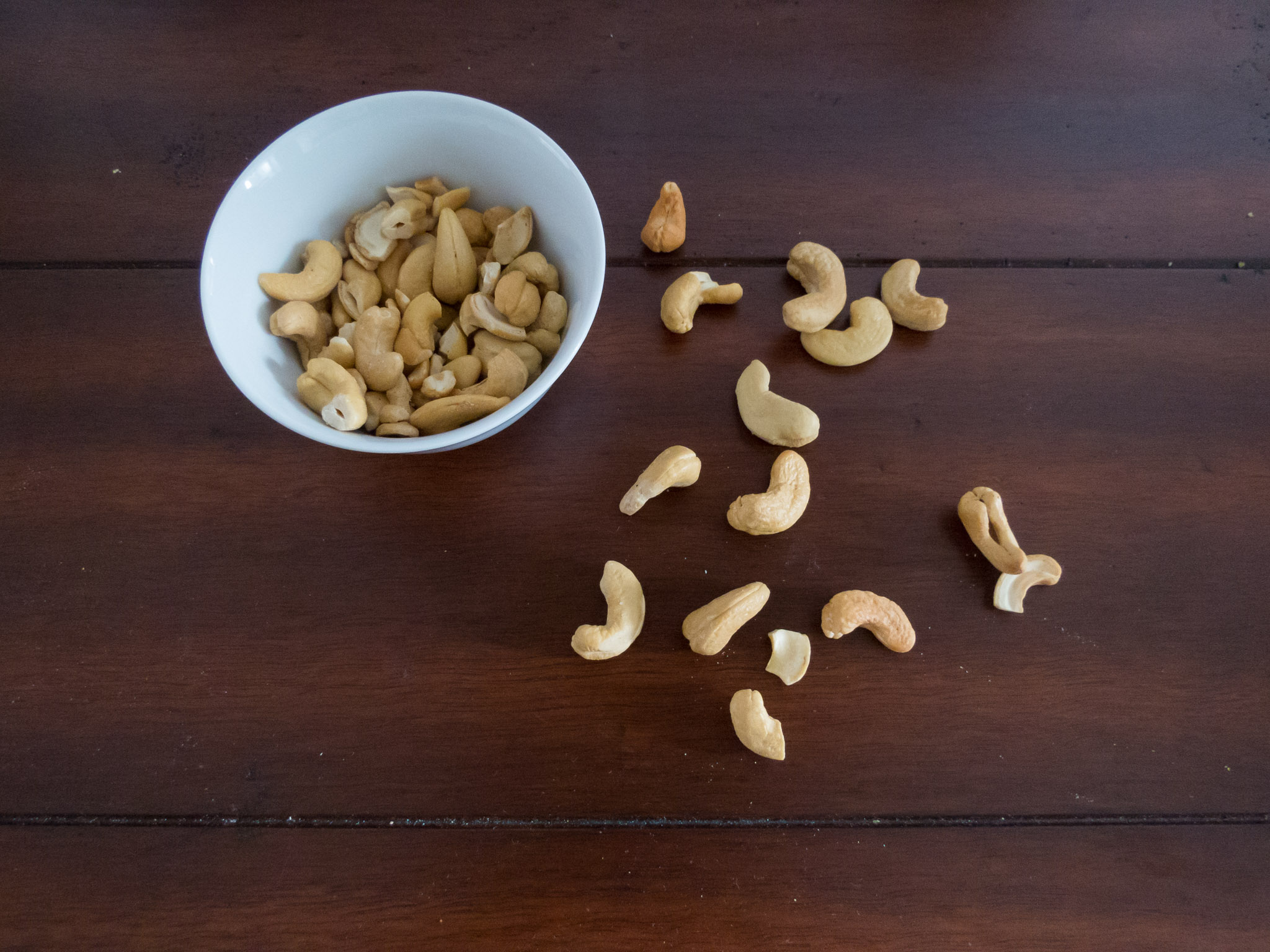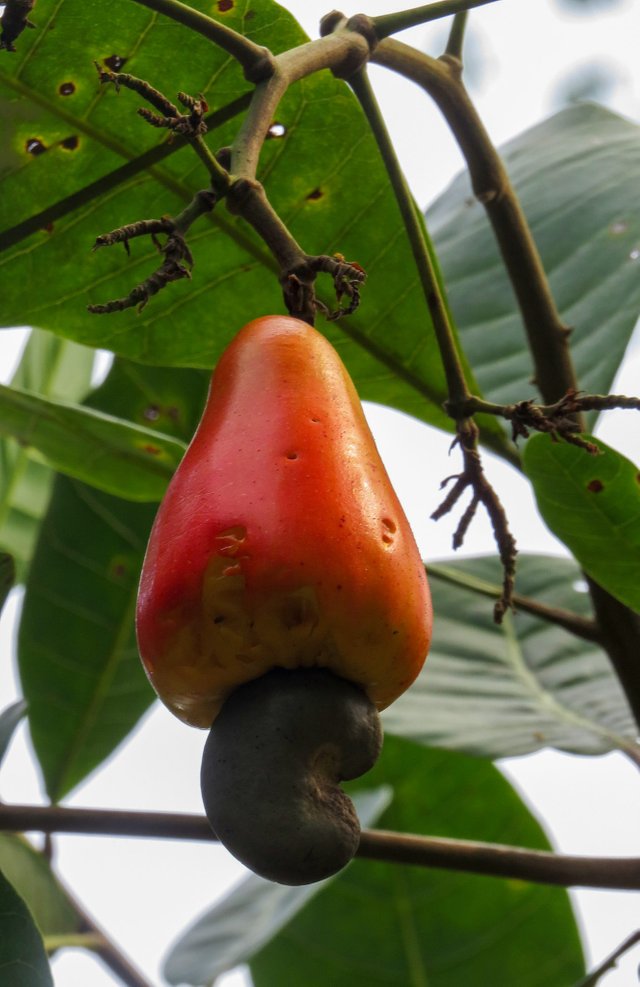What is actually Cashew!?
I never thought much about cashew. I buy my trail mix in the supermarket and besides many different nuts and dry fruits there are Cashew Nuts as well. It was clear Cashew - has to be a nut!
But from a botanical point of view, they are seeds!
The home of the Cashew tree is Brazil. Here the tree is called "Cajueiro" and the seed "Caju".

The curious thing about Cashew is that they are the only fruit of the world that do not carry their seeds inside. The seed is attached to the cashew fruit, the so-called cashew apple. Here in Brazil they make lot of juice from the fruit. I love it! The delicate taste is reminiscent of pineapple. Unfortunately, the fruit is easily perishable and therefore not suitable for export. Even in markets in southern Brazil, the fruit is rarely found.

The kidney-shaped nuts are roasted together with the thick, hard shell, heated with steam and then cracked. The tough, reddish skin surrounding the actual white cashew seeds is removed very carefully after reheating, the cashew seeds are sorted again and then dried three times at 60 - 80°C for 45 minutes to completely rid the cashews of moisture from the water vapour.
Than the seeds are ready to eat!
Deutsch:
Ich habe mir nie viele Gedanken über Cashew gemacht. Im Supermarkt kaufe ich mein Studentenfutter und neben vielen verschiedenen Nüssen und Trockenfrüchten sind auch Cashewnüsse enthalten. Für mich war klar: Cashew muss eine Nuss sein!
Aber aus botanischer Sicht sind sie Samenkörner!
Die Heimat des Cashewbaums ist Brasilien. Hier heißt der Baum "Cajueiro" und der Samen "Caju".
Das interessante an Cashew ist, dass sie die einzige Frucht der Welt ist, die ihre Samen nicht in sich trägt. Der Samen hängt an der Cashewfrucht, dem so genannten Cashewapfel. Hier in Brasilien wird viel Saft aus den Früchten gemacht. Ich liebe den Saft! Der köstliche Geschmack erinnert ein wenig an Ananas. Leider ist die Frucht leicht verderblich und daher nicht für den Export geeignet. Selbst auf Märkten im Süden Brasiliens ist die Frucht selten anzutreffen.
Die nierenförmigen Nüsse werden zusammen mit der dicken, harten Schale geröstet, mit Dampf erhitzt und dann geknackt. Die harte, rötliche Haut, die die eigentlichen weißen Cashewkerne umgibt, wird nach dem Wiedererwärmen sehr vorsichtig entfernt, die Cashewkerne werden nochmals sortiert und anschließend dreimal bei 60 - 80°C für 45 Minuten getrocknet, um die Cashewkerne vollständig von Feuchtigkeit aus dem Wasserdampf zu befreien.
Dann sind die Samen fertig für den Verzehr.
World of Photography Beta V1.0
>Learn more here<
Thank you for participating in #foodphotography
You have earned 5.05 XP for sharing your photo!
Daily photos: 1/2
Daily comments: 0/5
Multiplier: 1.01
Server time: 11:00:26
Total XP: 51.20/100.00
Total Photos: 9
Total comments: 5
Total contest wins: 0
Follow: @photocontests
Join the Discord channel: click!
Play and win SBD: @fairlotto
Daily Steem Statistics: @dailysteemreport
Learn how to program Steem-Python applications: @steempytutorials
Developed and sponsored by: @juliank
Ist es nicht so, dass bei der Herstellung der Cashewkerne wie wir sie kennen irgendein Öl austritt, das hochgiftig ist?
Ich dachte die Cashew kommt aus Afrika, weil sie dort so viel angebaut wird.
Das da ein Öl austritt ist mir nicht bekannt. Die Portugiesen haben den Cashewbaum von Brasilien nach Afrika gebracht. Ich glaube, mittlerweile kommen die meisten Cashews aber aus Asien.
Galileo hat einmal einen Bericht über den Herstellungsprozess der Cashew gedreht. Daher habe ich das im Hinterkopf behalten: https://tantelemi.wordpress.com/2017/06/15/cashewkerne-handarbeit-die-unter-die-haut-geht/
Ich liebe Cashews, die schmecken so leicht süßlich. Wusste aber bisher nicht sehr viel darüber. Danke für den informativen Bericht.
This post has received a 3.93 % upvote from @booster thanks to: @philippbuxbaum.